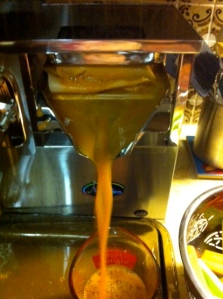The count: It’s been 467 days since I’ve taken juicing by storm (or should I say, juicing has taken my kitchen by storm)…I have juiced approximately 205 liters of delicious, nutrient filled juice, for myself and my athletes. I’ve experienced increased energy levels, quicker recovery times after workouts, and am generally feeling good!
There are several different types of juicers on the market, the most common being the centrifugal juicer and the masticating juicer. (http://www.harvestessentials.com/whatjuicisri.html). The centrifugal juicer first pulps any vegetables or fruit that you are juicing, and then spins the pulp at high RPMs, creating centrifugal force that pushes the juice through screens. It’s the most prevalent juicer out there, also the most affordable, but has its downsides. Centrifugal juicers don’t yield very high amounts of juice from leafy greens or grasses, such as wheatgrass, parsley, kale, etc., and the pulp is fairly wet – meaning that a good amount of juice is left behind with the discarded plant fibers. Another disadvantage of a centrifugal juicer is that the high speed of the spinning mechanism causes large amounts of oxygen to mix with the juice during the process, resulting in a quicker spoiling time of the juice.
The masticating juicer uses a mashing or chopping mechanism to crush the fruit and vegetable contents, resulting in more of the minerals, nutrients and vitamins to be pulled from the plant fibers. The lower RPM of the crushing mechanism result in a longer shelf life compared to the centrifugal juicer, but they are typically a bit more expensive. Some masticating juicers implement a second pressing stage, which presses juice from the crushed pulp and increases the overall efficiency of the juicing process.
I have the Norwalk Juicer Model 275, which implements a two-part process to pull every last speck of nutrients from the fruit and veggie fibers. (See pic below)…
The first part uses a vortex triturator, which is a helical cutting and grinding mechanism that breaks the plant fibers down to the cellular level of raw foods. The low RPMs of the mechanism minimize the amount of heat and air that the plant fibers are exposed to, thus improving the quality and shelf life of the juice and maximizing the extraction of nutrients during the second phase – pressing. The Norwalk juicer uses a hydraulic press to squeeze the juice from the pulp. This pressing action separates the micro-nutrients, enzymes, trace minerals and vitamins that bind to the fruit and veggie fibers and wouldn’t be released by the other juicing methods.
The chart below shows the comparisons of nutrient-content in juice pulled from different types of machines. Machine A is described as the leading centrifugal juicer, Machine B is a masticating juicer, and Machine N is the Norwalk…Clearly, the Norwalk wins 🙂
Storing juice in the correct manner is also extremely important — the more air you expose the juice to, the quicker it is to oxidize and lose its nutrient content and flavor. I store my juice in sealed glass mason jars in the fridge, and it can last for a few days up to a week. You can also freeze juice in ice-trays for up to 6-months (http://www.norwalkjuicers.com/model-275/).
Different vegetable blends obviously yield different nutrient contents, and depending on what you’re juicing for, you may want to focus your juicing efforts on specific nutrients. More to come soon with regards to juice blends and nutrient levels!
Enjoy and happy juicing, I couldn’t encourage you more to add this to your life for health and athletic performace. I hope the information is helpful to all!


